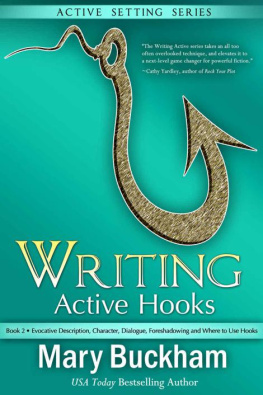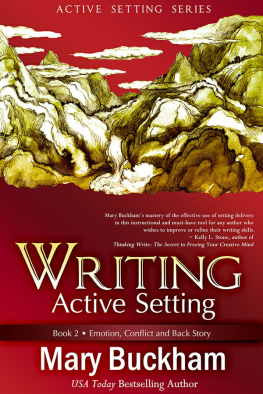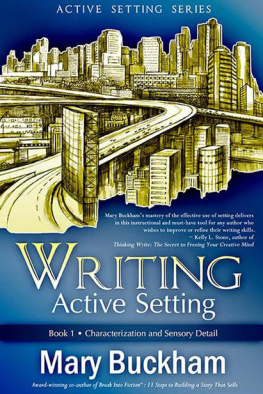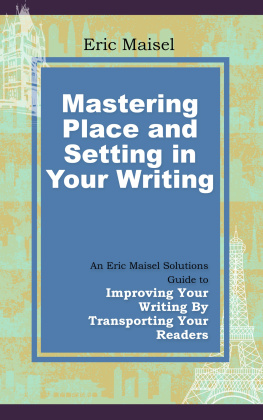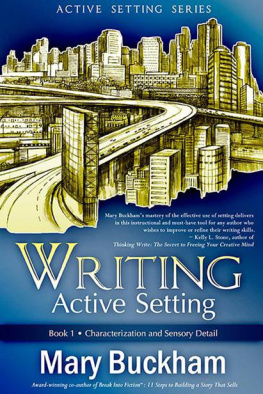Writing Active Setting
Book 3: Anchoring, Action, as a Character and More
Content copyright 2013 by Mary Arsenault Buckham
All rights reserved.
First Edition
No part of this book may be reproduced or utilized in any form or by any means, electronic or mechanical, including photocopying, recording, or by any information storage and retrieval system without permission in writing from the publisher.
Published by
Cantwell Publishing LLC
2675 Wilson Street
Port Townsend, WA 98368
USA
ISBN: 978-1-939210-09-8
Interior and cover design by
THE KILLION GROUP, INC.
www.thekilliongroupinc.com
ACKNOWLEDGEMENTS
Writing any book does not happen in a v acuum, especially a how-to craft book. Id like to thank the hundreds and hundreds of writing students who helped define the assignments and the need to explore how to better use Setting in our novels. Id also like to thank my early readers, all writers who gave invaluable feedback on the format and content of this book: Theresa Rogers, Debbie Kaufman, Dorothy Callahan, and Laurie G. Adams. Any of your great advice I did not take was my fault alone. A special thanks to those writers who read the first books in this series: WRITING ACTIVE SETTING: Book 1Characterization and Sensory Detail, and WRITING ACTIVE SETTING: Book 2 Emotion, Conflict, and Back Story and who took the time to post a review or inspired writing friends to grab a copy of that book. You rock!
A special shout out to Laurie Schnebly Campbell, co-founder with me of www.WriterUniv.com an d a whiz with back cover blurbs, Kimberly Killion and her able assistant, Jennifer Jakes, of HOT DAMN Designs who really know how to design a killer cover and make the process painless and to my husband, Jim Buckham, who makes all things possible in my world. Last, but not least, thanks to my readers. Without you, Id have no craft to teach.
Thank you!
Dedicated to the writers everywhere who constantly work to expand their understanding of the craft of writing!
Note to Readers:
Every effort has been made to cleanly edit the text. However, typos do slip in. If you find an error in the text, please email so the issue can be corrected. I appreciate you as a reader and want to make sure you enjoy the reading and learning process. If you find errors, please bring them to my attention so I can continue to provide better books for all.
Thank you!
Table of Contents
Overview
Part 1 * SETTING TO ANCHOR THE READER
Introduction
Using POV to Anchor Setting
Deeper POV to Anchor Setting
Transitioning via Setting
Transitioning via Same Setting from Different POV
Chapter and Scene Beginnings
What Not To Do
Assignment
Recap
Part 2* SETTING IN AN ACTION SEQUENCE
Overview
Movement through Space
What Not T o Do
Assignment
Recap
Part 3* SETTING AS A CHARACTER
When Place Matters
Setting in a Series
Assignment
Recap
Part 4 * DEVIL IN THE SETTING DETAILS
Overview
Other Details to Remember
Additional Setting Pitfalls
Wrap Up: What Makes a Great Setting
Bibliography
What Folks Are Saying About the Active Setting Series
WRITING ACTIVE SETTING
BOOK 3: ANCHORING, ACTION SEQUENCES, AS A CHARACTER, AND MORE
OVERVIEW
In strong writing there is always an overlap of craft techniques resulting in a more integrated story. Nothing lives in isolation. So, for those who have read the first two books in this series Writing Active Setting Book 1: Characterization and Sensory Details , or Book 2: Emotion, Conflict, and Back Story you will notice that Anchoring the Reader as explained in this book enhances what you learned about Characterization in Book 1, and Setting in an Action Sequence as explained in this book will cover elements of Conflict that you learned about in Book 2. This is necessary; both for combining the elements into a seamless unit and for helping you assimilate by repetition.
Were looking at very different examples in this book, so you dont need to read Book 1 or Book 2 to understand and embrace the concepts here, but these concepts build on one another as blocks laid in an interlaced pattern create a strong structure. The more you learn about writing Active Setting, the more you will be able to add depth and texture to your writing as you explore opportunities to use the material.
Part 1:
SETTING TO ANCHOR THE READER
INTRODUCTION
Using S etting to anchor, or orient, the reader as to the when and where of the story is very important to the success of that story. Anchoring is created when the reader is better able to picture the where and when of the story, which creates a stronger emotional tie by the reader to the character in the story, and thus to the story.
Since most of us have only read published novels, its hard to show how this small detail can separate the published from the unpublished, but if youve had the chance to read unpublished work for contests, or worked with newer writers, youve likely seen this lack of anchoring time and time again. Theres a reason for this lacktwo, actually.
The first re ason, and the most common one, occurs because as we write we can be so deep into the world of our characters that we assume more information is on the page than is really there. So when we say mountain we assume the reader can see a ten thousand-foot former volcano while your reader may imagine a thousand-foot bump rising out of a flat landscape, or a jagged granite edifice that fronts more mountains such as how one sees the Rocky Mountains if traveling west from the plains. Their vision is based on their knowledge and experience, not on what youre showing them on the page.
If your character is flying a plane thats lost power midair and is heading right for the mountain, these interpretations will make a huge difference.
NOTE : Specific details can paint a much clearer and stronger image for the reader than generic, vague details. If the Setting matters to the story, aim for specific, like making that plane heading for the mountain a Cessna 206.
The second most common mistake is forgetting that the reader may have set the book down at the end of the last chapter, or scene, or you have ended a scene in one location and opened the next chapter, or scene, in a new location. Either way the reader needs to get re-oriented quickly so they can slip back into the story world and move forward with the action.
NOTE : Always be aware of your intention on the page. The more detail or words allocated to a description, the more you are telling the reader that this Setting matters. If it doesnt matter, dont give weight to the Setting by being overly specific with the description of a room, a city block, or, as we used above, a mountain.
USING POV TO ANCHOR SETTING
Think about how you can anchor the reader in the Setting early in the scene. One way to do this is by actually describing the Setting in an omniscient way, with a big overview perspective. This means the scene is not seen or experienced through any of the characters POV (point of view), but instead as if the reader is looking through a camera lens thats been pulled way back to give a panoramic sense of place. Look at the following example from Robert Ludlums The Icarus Agenda :
The angry waters of the Oman Gulf were a prelude to the storm racing down through the Strait of Hormuz into the Arabian Sea. It was sundown, marked by the strident prayers nasally intoned by bearded muezzins in the minarets of the port citys mosques. The sky was darkening under the black thunderheads that swirled ominously across the lesser darkness of evening like roving behemoths. Blankets of heat lightning sporadically fired the eastern horizon over the Marran Mountains of Turbat, two hundred miles across the sea in Pakistan. To the north, beyond the borders of Afghanistan, a senseless, brutal war continued. To the west an even more senseless war raged, fought by children led to their deaths by the diseased madman in Iran intent on spreading his malignancy. And to the south was Lebanon, where men killed without compunction, each faction with religious fervor calling the other terrorists when allwithout exceptionindulged in barbaric terrorism.
Next page

